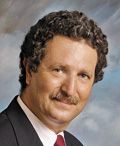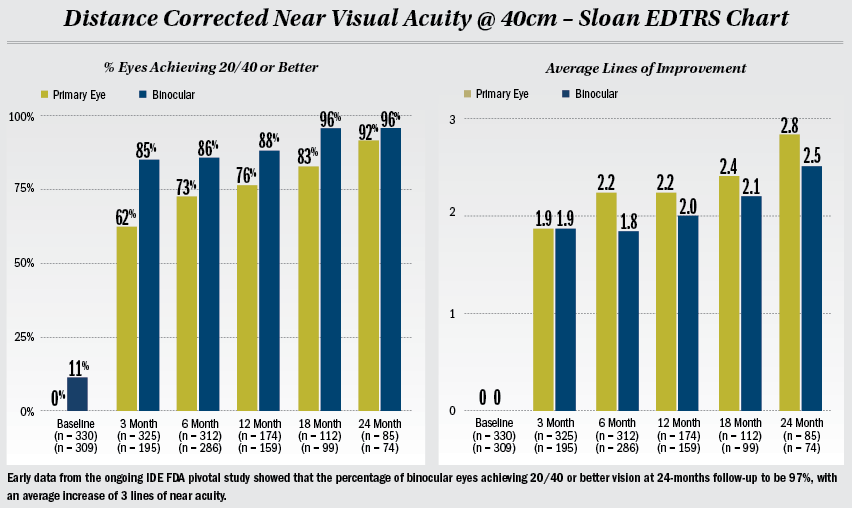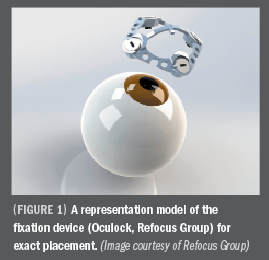Article
Refocus Scleral Implants for presbyopia
Refinements in the design of the Refocus Scleral Implants (Refocus Group) to treat presbyopia (and glaucoma) and in the surgical implantation technique have improved markedly over the year, making the devices easier to implant and the surgery shorter.
Take-Home
Refinements in the design of the Refocus Scleral Implants (Refocus Group) to treat presbyopia (and glaucoma) and in the surgical implantation technique have improved markedly over the year, making the devices easier to implant and the surgery shorter.
By Lynda Charters; Reviewed by Barrie Soloway, MD

Dr. Soloway
New York-Over the past 12 months, refinements in the design of the Refocus Scleral Implants (Refocus Group) and advancements in the surgical implantation technique have made the unique binocular Refocus Scleral procedure for presbyopia correction (and glaucoma treatment), more precise, faster, and importantly more comfortable for the patient.
During implantation, the basic procedures include: determining the positions of the four scleral implants, creation of four lamellar scleral tunnels to accommodate the devices, insertion of the devices, and the conjunctiva closure, explained Barrie Soloway, MD.
Dr. Soloway is director of vision Correction, New York Eye and Ear Infirmary, New York, and has been medical director, Refocus Group since 2003.

Precise positioning
From 1998 to 2007, in the initial FDA clinical trial when the scleral implants were first being evaluated, a Meridian marker was used in marking of the cornea and calipers were used to determine the positions of the implants and to specify the location of the footplate and its grips. This inexact process resulted in a compounding of errors with multiple step measurements and therefore was less accurate in positioning the scleral implants.
In the FDA pivotal clinical trial from 2008 to 2012, there was an initial evolution to improve accuracy, with specialized markers used to determine the position of the Refocus scleral implants.
However, the surgeon was still required to line up the marks visually with the instrumentation.
The latest step in this evolution is the use of the Oculock fixation device (Refocus Group) for exact placement (Figure 1).
“The Oculock ‘locks’ onto the eye with four point fixation and a scleratome physically ‘docks’ into the correct position on the eye. This instrument facilitates efficient, accurate, uniformly positioned tunnels [Figure 2],” Dr. Soloway said.

Accurate tunnel creation
This step in the implantation process has evolved markedly from the initial use of a manual diamond blade between 1998 and 2004 requiring surgeon skill and judgment and resulting in tunnels that were potentially not uniformly deep. Surgeons then graduated to using an electric scleratome from 2004 to 2012. This proved to be a bulky instrument, and positioning of the tunnel was difficult because of the speed of transit and inertia, he said.
The introduction of the disposable scleratome into the procedure in 2012 overcame these disadvantages.
The instrument that docks to the Oculock fixation device is lightweight and ergonomically designed, being easy to handle and is delivered sterile and pre-assembled. The surgical time is decreased and the procedure easier and safer, according to Dr. Soloway.
The implant originally was a one-piece device from 2000 to 2006 that was pushed into place and was difficult to thread through the tunnel. The implant first had a uniform width, but research over the long term showed these implants had a tendency to slip out of the tunnel, resulting in a return to the subjects’ preoperative near vision.
In 2007, a redesign of the Refocus Scleral implant improved its stability in the eye by keeping it from shifting.
Each implant-which is the size of a grain of rice and constructed of polymethyl methacrylate-now has two interlocking parts: a split leg piece and a male head locking insert and is pulled into place by a shuttle and tubing. The shuttle threads through the tunnel and the tubing maintains a minimal cross section width until the implant clears the tunnel. The insert is locked into place (Figures 3 and 4).
Both ends of the implant are wider than the tunnel, which prevents slippage out of the tunnel.

Transforming suturing
Various suture methods have been used from 1998 to 2012 in the US clinical trials. However, these caused a foreign body sensation and reduced tear film stability.
A fibrin tissue sealant was introduced in 2010 that is currently used only internationally.
“This sealant has resulted in increased patient comfort, improved cosmesis, and improved tear film stability,” Dr. Soloway said.
“This procedure is much easier to perform in 2013 compared with previous years,” he said. “The advancements of the techniques have led to continued successful results seen in a FDA investigational device exemption clinical study and in international studies.”
Early data from the ongoing IDE FDA pivotal study presented in October at the European Society of Cataract and Refractive Surgeons in Amsterdam, showed that the percentage of binocular eyes achieving 20/40, or better vision at 24-months follow-up to be 97%, with an average increase of 3 lines of near acuity, Dr. Soloway said.
“The procedure has truly evolved,” he said, “surgical time has been decreased significantly, results have improved, we have consistent outcomes, and much happier patients.”
Barrie Soloway, MD
E: bds@ihateglasses.com
Dr. Soloway receives consulting and travel fees from Refocus Group Inc. This device and surgery is CE marked and available in Europe and elsewhere through Refocus Ocular BV, The Netherlands. The device is under FDA IDE in the United States with an earlier surgical procedure through Refocus Group Inc., Dallas.
Subscribe to Ophthalmology Times to receive the latest clinical news and updates for ophthalmologists.
Newsletter
Don’t miss out—get Ophthalmology Times updates on the latest clinical advancements and expert interviews, straight to your inbox.




